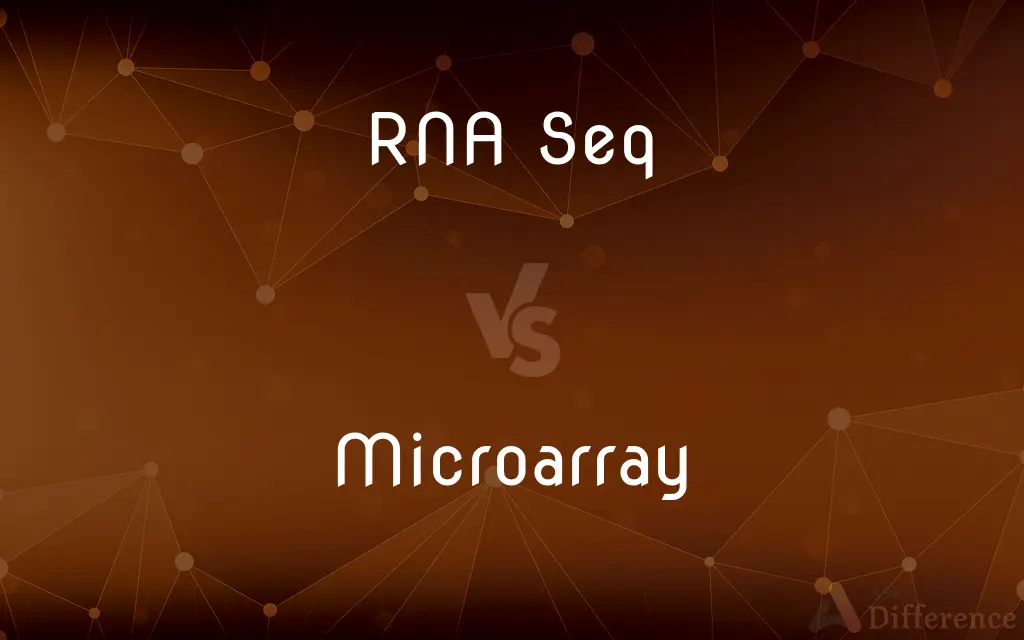RNA Seq vs. Microarray — What's the Difference?
Edited by Tayyaba Rehman — By Fiza Rafique — Published on December 15, 2023
RNA Seq uses sequencing to quantify gene expression, providing detailed transcript information. Microarray measures expression by hybridizing labeled cDNA to predetermined probes on a chip.

Difference Between RNA Seq and Microarray
Table of Contents
ADVERTISEMENT
Key Differences
RNA Seq and Microarray are both powerful techniques used to study gene expression. While RNA Seq harnesses the capabilities of high-throughput sequencing to provide a comprehensive view of the transcriptome, Microarray involves binding labeled cDNA samples to predefined probes on a chip to measure gene expression.
The method of RNA Seq is particularly favored when one requires detailed insights into the transcriptome, including alternative splicing events, novel transcripts, and sequence variations. On the other hand, Microarray has been a staple in genomic research for years, providing a quick way to gauge the expression of known genes under varying conditions.
An advantage of RNA Seq is its ability to quantify gene expression with high resolution and without prior knowledge of the sequence. This makes it especially valuable in studying non-model organisms or detecting novel transcripts. Microarray, however, relies on previously known sequences for probe design, making it suitable for well-studied organisms and focusing on known genes.
When considering cost and throughput, RNA Seq is generally more expensive due to the sequencing involved but offers unparalleled depth of data. Conversely, Microarray can be more cost-effective for large-scale screenings, especially when investigating known genes in model organisms.
In terms of data analysis, RNA Seq produces vast amounts of raw sequencing data that require robust computational tools for analysis. Microarray data, while more straightforward to analyze, might be limited by background noise and cross-hybridization issues.
ADVERTISEMENT
Comparison Chart
Technique Basis
Sequencing-based
Hybridization-based
Data Output
Comprehensive transcriptome view
Expression levels of predefined genes
Applications
Novel transcripts, alternative splicing, variants
Known gene expression profiling
Cost
Generally higher
More cost-effective for large-scale screenings
Prior Knowledge Needed
None (sequence-independent)
Requires known sequences for probe design
Compare with Definitions
RNA Seq
Sequencing-based approach to capture the diversity and abundance of RNA species.
With RNA Seq, scientists can detect low abundance transcripts more efficiently.
Microarray
A high-throughput method to measure mRNA abundance using predefined gene probes.
Scientists used Microarray analysis to compare gene expression profiles of normal and diseased tissues.
RNA Seq
A technique employing high-throughput sequencing to profile and quantify RNA molecules.
Researchers used RNA Seq to explore the differential expression of genes in cancer cells.
Microarray
A chip containing DNA probes to which labeled cDNA samples are hybridized.
The Microarray data showed significant upregulation of specific genes under stress conditions.
RNA Seq
A tool to map and quantify RNA molecules, offering insights into gene expression.
The advantages of RNA Seq include its ability to identify novel transcripts without prior knowledge.
Microarray
A slide-based tool for large-scale gene expression studies.
The Microarray platform has been instrumental in identifying genes associated with specific diseases.
RNA Seq
A method for analyzing the entire transcriptome using sequencing technology.
RNA Seq provides a detailed view of the transcriptional landscape, revealing alternative splicing events.
Microarray
A technology used to detect the expression levels of thousands of genes simultaneously.
Microarray experiments helped in understanding the genetic response of plants to drought conditions.
RNA Seq
An approach to study the dynamic nature of RNA in a genome through sequencing.
RNA Seq has revolutionized the field of transcriptomics, enabling researchers to explore gene expression patterns in depth.
Microarray
A method that uses known DNA sequences to assess gene expression across samples.
Using a Microarray, the research team was able to identify key genes involved in the metabolic pathway.
Microarray
See DNA microarray.
Microarray
Any of several devices, containing a two-dimensional array of small quantities of biological material, used for various types of assay; the assay itself
Common Curiosities
Can Microarray detect novel transcripts?
No, Microarray is designed to measure expression of known genes based on predefined probes.
Is RNA Seq always the better choice?
Not necessarily. The choice depends on the research goal, budget, and desired depth of information.
Why might researchers choose RNA Seq over Microarray?
RNA Seq can identify novel transcripts, sequence variants, and does not need prior sequence knowledge.
Do both RNA Seq and Microarray need RNA samples?
Yes, both techniques analyze RNA, but RNA Seq sequences it while Microarray measures its hybridization.
Is RNA Seq more accurate than Microarray?
RNA Seq offers higher resolution and can be more accurate, especially for low-abundance transcripts.
Can RNA Seq be used for non-model organisms?
Yes, RNA Seq doesn't require prior sequence knowledge, making it ideal for non-model organisms.
Why is RNA Seq data analysis more computationally intensive?
RNA Seq produces vast amounts of raw sequencing data, requiring powerful tools for alignment, quantification, and interpretation.
Is Microarray becoming obsolete?
While RNA Seq offers more depth, Microarray remains valuable for specific applications and large-scale screenings.
What is the data output difference between RNA Seq and Microarray?
RNA Seq provides sequence reads and detailed transcript information. Microarray provides fluorescence intensities corresponding to gene expression.
How does RNA Seq handle alternative splicing?
RNA Seq can identify and quantify multiple splice variants of a gene.
What organisms are suitable for Microarray analysis?
Microarray is best suited for well-studied organisms with known gene sequences.
What are some limitations of Microarray?
Potential cross-hybridization, background noise, and reliance on known sequences are some limitations.
How has RNA Seq impacted transcriptomics?
RNA Seq has provided deeper insights into transcriptome complexities, including alternative splicing and novel transcripts.
Can Microarray detect mutations?
Microarray is primarily for expression analysis, not mutation detection. RNA Seq can detect sequence variations.
What kind of biological questions can Microarray answer?
Microarray can identify differentially expressed genes between conditions, disease markers, and gene pathways.
Share Your Discovery

Previous Comparison
NMOS vs. PMOS
Next Comparison
Holiday Inn Express vs. Holiday InnAuthor Spotlight
Written by
Fiza RafiqueFiza Rafique is a skilled content writer at AskDifference.com, where she meticulously refines and enhances written pieces. Drawing from her vast editorial expertise, Fiza ensures clarity, accuracy, and precision in every article. Passionate about language, she continually seeks to elevate the quality of content for readers worldwide.
Edited by
Tayyaba RehmanTayyaba Rehman is a distinguished writer, currently serving as a primary contributor to askdifference.com. As a researcher in semantics and etymology, Tayyaba's passion for the complexity of languages and their distinctions has found a perfect home on the platform. Tayyaba delves into the intricacies of language, distinguishing between commonly confused words and phrases, thereby providing clarity for readers worldwide.












































